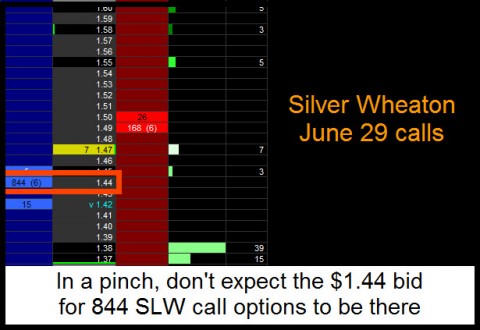An amusing coincidence: I was posting to the Rick’s Picks forum a moment ago about how exchange trading has come to resemble a sleazy carnival operation, and lo, the E-Mini S&Ps have shot up six points in mere seconds. This was an after-hours move – the best time to stage these heists, since there is little legitimate buying or selling to get in the way of the perpetrators. I don’t wish to insult carny operators by comparing them to exchange dealers and market makers, by the way, since the guys and gals who work the midway at least come face to face with the rubes they are ripping off. Not in the world of electronic trading, though. The pros who are doing the fleecing operate under a veil of secrecy that can be lifted only by securities regulators or the FBI.
The forum thread concered trading against phantom bids and offers that seem to be there only when you don’t need them. Café Americain’s Jesse had posted the following at his own blog: “I am not trading nearly as frequently or aggressively as in the past because a) I am getting older b) these markets are almost ridiculous. It’s like playing cards with the little girls. If I put in an order for a few thousand shares, the liquidity from a large offered set of multiple positions evaporates instantly and I close on maybe 100 shares. If I offer to buy above market but below ask I get ten ‘friends’ appearing instantly along with my bid.”
Phantom Markets
Just so. This has been our experience as well, mainly in the equity option markets. On a Level 2 trading screen, one might see 5000-up bids and offers for call options that rarely trade. So who would be offering thousands of them, and for what reason? Some might suspect high-speed (“algo”) traders, but that’s not how those guys work. Typically, high-frequency trading takes place without the display of bids and offers. How could they be reflected on a screen, given that such trades are sometimes effected at the rate of hundreds or even thousands per second? No, the phantom bids and offers that are reflected so ostentatiously have been put there by neural-network computers programmed to act only if an offsetting, highly advantageous opportunity arises.
I learned about this shell game the hard way when I worked as an option market maker on the floor of the Pacific Exchange during the 1980s. Market makers typically did not trade with each other, nor did they honor each other’s markets. Turn to one of them in a desperate attempt to buy a dozen puts or calls, and they would tell you to take a hike. Imagine my excitement when Timber Hill moved into the Microsoft pit where I traded. The firm’s broker supposedly stood ready to honor 100-up markets in any put or call. Except that they would move those bids and offers out of range whenever some trivial market change occurred that might have given me an edge on an arbitrage. For instance, I might have been be waiting for an uptick in some obscure stock to signal an end-of-day short squeeze in computer stocks. Turning to Timber Hill’s broker, I would shout, “Buy 100 of the Jan 60 calls for 1.30.” To which he would reply, “I’m at 1.40 now.” Could their neural-networked computer have been monitoring the same obscure stock for signs of an impending market move? Possibly. More likely is that their machine was watching ten other indicators that it had learned would move before my “trigger” stock knew what hit it.
High-frequency trading operates at a level even further removed from reality. Regulators have recently begin scrutinizing this game, but merely doing so may obligate them to shut the whole business down, since there is no legitimate or even redeeming rationale for the practice. Don’t be surprised if this happens within the next twelve months. It won’t make the game any cleaner, only a smidgen less absurd.
***
Is It Over for Apple?
We’ve been following Apple shares closely, since, if its spectacular bull market is over, so is the Mother of All Bear Rallies begun on Wall Street in March of 2009. Yesterday, Apple did something that should have scared bulls out of their pants. If you want to find out what, try a free trial subscription to Rick’s Picks by clicking here.
***
Win a Subscription Worth $106!
If you aren’t already receiving these commentaries by e-mail, sign up now and you’ll be automatically entered in a weekly drawing to win a three-month Rick’s Picks subscription worth $106. Click here to register. What do paying subscribers get that lurkers don’t? Plenty, including detailed daily trading “touts” and access to a 24/7 chat room that draws traders from around the world.


Another thing screwing up the markets are those damnable tracking ETF’s. If the majority of the investment money is going into the ETF then there is nothing left to go into the stocks that the ETF’s are supposed to be tracking. Result? Downward trend. Gold equities anyone?